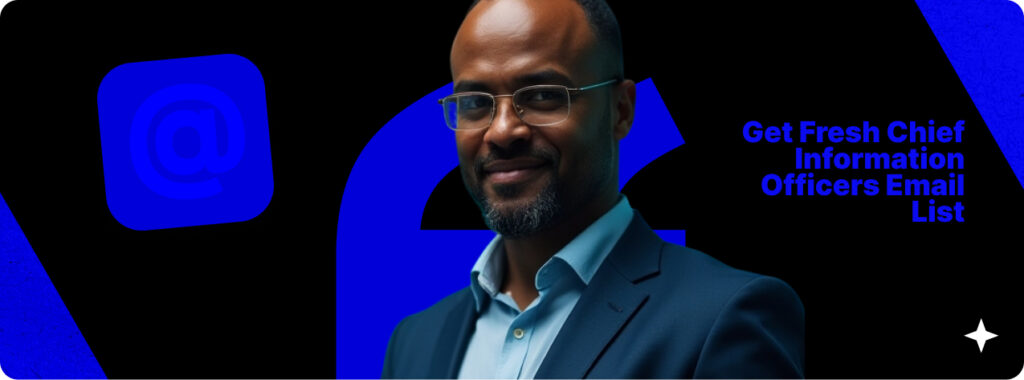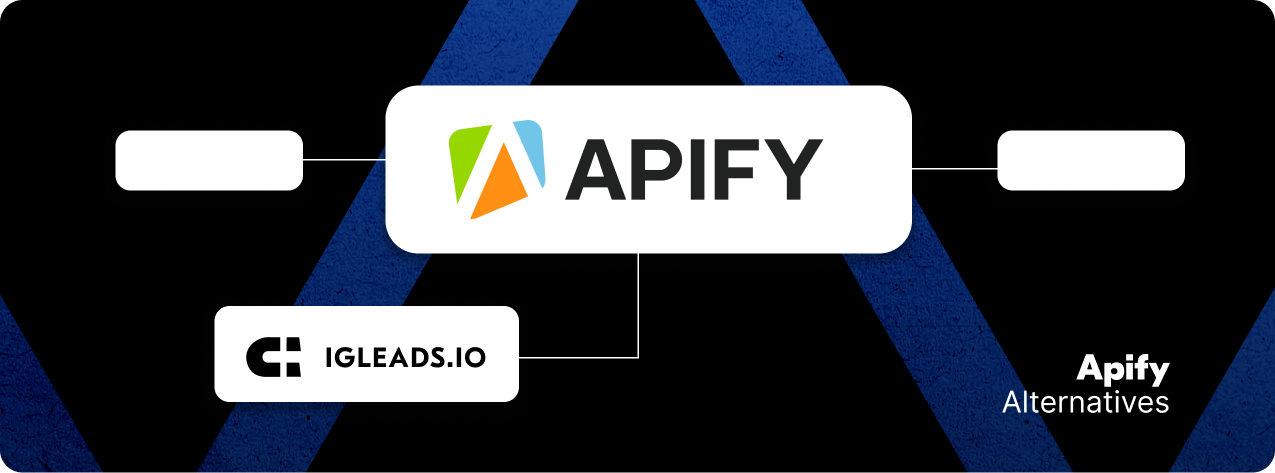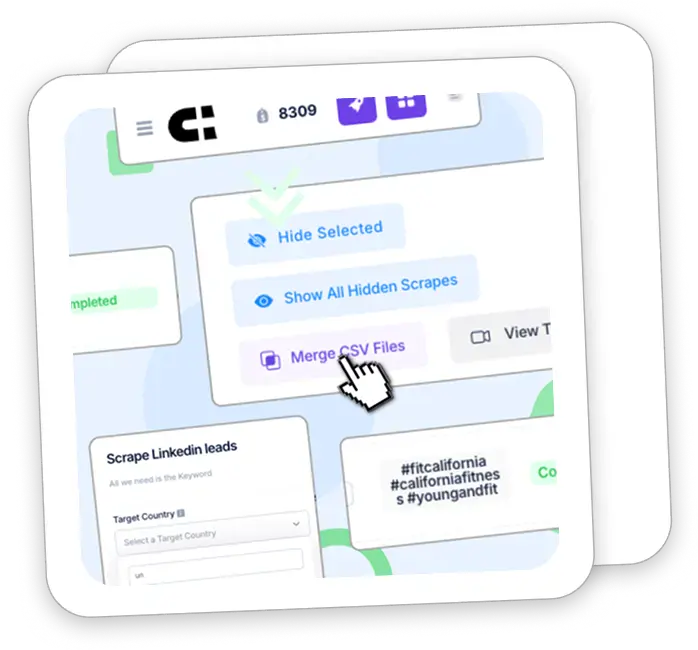Get Fresh Chief Information Officers Email List 2025

Looking for a reliable CIO email list in 2025? You can buy one or build your own. This guide covers both. We’ll compare vendors, show you where to find CIO contacts online, and walk through creating a targeted list with an email scraper like IGLeads. You’ll see how to filter by industry, location, or company size, export to CSV, and keep your outreach compliant so your campaigns reach the right technology decision-makers.
Top 5 ways to get fresh CIO email lists
Getting accurate and updated contact data for Chief Information Officers is all about choosing the right sources. Whether you’re building your list from scratch or enhancing your current database, these five proven methods will help you access verified, high-value CIO email addresses.
1. Use company websites and leadership directories
Many companies, especially those in tech, finance, and enterprise sectors, publish executive bios and leadership team info on their websites. You can often find CIO names, roles, and occasionally contact emails or LinkedIn profiles.
Tip: Use tools like Hunter.io or manual search strings (e.g., “site:company.com CIO email”) to uncover public-facing contact details. From there, you can verify the format of email addresses (e.g., firstname.lastname@company.com) and build targeted outreach lists.
2. Tap into LinkedIn and professional networks
LinkedIn is one of the richest sources of CIO data. The platform lets you filter by job title, location, industry, and company size. Most CIOs maintain active LinkedIn profiles for networking and visibility.
To build your list:
- Use LinkedIn Sales Navigator to narrow your search
- Connect with CIOs and follow up with value-led messages
- Check if emails are available via public profiles or company domains
- Engage with CIO posts to build familiarity before outreach
This approach works especially well when paired with email scraping tools that extract data from connections at scale.
3. Use email scraping tools like IGLeads.io
If you’re looking to speed things up, email scraping tools like IGLeads.io offer a more automated solution. You can target CIOs by job title, industry, or geography across platforms like LinkedIn and Google Maps, pulling accurate, export-ready email data into your CRM.
IGLeads works without coding and helps you extract:
- Names
- Job titles
- Emails
- Company names
- Location data
- Social profiles
With filters for company type and industry, you can focus only on the contacts that match your offer, whether you’re targeting CIOs in fintech startups or multinational enterprise firms.
4. Buy from verified enterprise data providers
Purchasing a CIO list from a reputable vendor gives you immediate access to pre-filtered, ready-to-use contact data. These providers typically offer:
- Compliance with GDPR and CAN-SPAM
- Industry or role-specific segmentation
- Monthly or quarterly updates
- Bounce protection and email verification guarantees
Vendors like BookYourData and UpLead offer CIO-specific lists filtered by industry, geography, and even technology stack. Always review the provider’s data policies before purchasing.
5. Leverage IT industry events and registration lists
Webinars, conferences, and summits focused on enterprise technology often collect attendee information from CIOs and other high-level IT decision-makers. Sponsoring or hosting events gives you first-party access to these contacts.
You can also request attendee lists or use event networking tools to connect with CIOs directly. Look for popular events like:
- Gartner IT Symposium
- CIO 100 Awards
- TechCrunch Disrupt (for startup CIOs)
- Local industry-specific events (e.g., fintech or healthcare IT)
Event-sourced lists often have higher response rates since the contacts are already engaged with the subject matter.
Benefits of targeting verified CIO email addresses
Targeting CIOs with a verified email list unlocks some of the most valuable connections in B2B marketing. CIOs are not just IT heads, they are strategic leaders who influence enterprise-wide decisions on infrastructure, cybersecurity, digital tools, and budget allocation.
Here are the top advantages of working with a verified CIO email list in 2025:
1. Reach true decision-makers
CIOs oversee major technology purchases and digital transformation initiatives. With verified contact data, you skip past generic support lines and speak directly to the people who actually make the call on software, hardware, and service providers.
2. Improve deliverability and reduce bounce rates
A verified list filters out outdated titles, inactive emails, and incorrect domains. This ensures your emails reach real inboxes and preserves your sender reputation. In most cases, a good CIO email list can offer 90–95% deliverability rates when kept updated monthly.
3. Run smarter, segmented campaigns
Not all CIOs manage the same kinds of IT ecosystems. With a quality list, you can segment by:
- Industry (finance, healthcare, education, manufacturing, etc.)
- Company size (SMBs vs enterprise)
- Region (state, country, or global targeting)
- Tech stack (cloud-first vs hybrid, legacy systems vs modern platforms)
This segmentation helps tailor messaging to each CIO’s actual challenges, whether it’s digital adoption in legacy sectors or scaling SaaS infrastructure across global offices.
4. Increase ROI from your outreach
CIOs represent high-value prospects. If you’re offering an enterprise solution, even a single conversion can be worth tens of thousands in contract value. Email remains one of the highest-ROI channels, generating over $40 for every $1 spent. With accurate, verified CIO emails, you reduce waste and focus on qualified leads that drive revenue.
5. Build long-term partnerships
CIOs aren’t just buyers, they’re collaborators. A successful email campaign can lead to multi-year vendor relationships, pilot programs, referrals across departments, and even advisory input if you’re in the product development space.
Whether you’re promoting enterprise software, IT services, infrastructure solutions, or cybersecurity tools, a verified CIO contact list is the foundation for efficient, effective B2B growth.
What to check before buying a CIO email list
Not all email lists are created equal, especially when it comes to targeting high-level executives like Chief Information Officers. Before spending money on a CIO email list, you need to evaluate the data quality, sourcing methods, compliance practices, and filtering options.
Here are four key factors to check:
1. Is the data recent and regularly updated?
CIOs are frequently promoted, change companies, or move to different roles. If the data is outdated, your emails won’t reach the right people, and your bounce rates will spike. Look for vendors who:
- Update their database at least monthly
- Remove inactive domains and verify job titles
- Guarantee a minimum 90%+ deliverability rate
- Offer replacement contacts if a portion of emails fail
Providers like BizProspex and Prospect Wallet lead the space in keeping executive data fresh through manual and automated verification.
2. Can the list be filtered by company type or industry?
You’ll get better campaign performance by narrowing your outreach to CIOs that actually align with your offering. Check if the list allows segmentation by:
- Company size (startup vs mid-market vs enterprise)
- Industry (e.g., retail, finance, healthcare, SaaS)
- Region or country
- Tech stack preferences (cloud, on-prem, hybrid)
Smart filtering helps tailor your message. For example, a cybersecurity platform for finance will perform better when sent only to CIOs in financial institutions, rather than a generic B2B blast.
3. Is the list compliant with data laws like CAN-SPAM or GDPR?
This is non-negotiable. Emailing CIOs without compliance can result in penalties, and harm your sender reputation. A compliant CIO email list should be:
- Collected from public, legal, and opt-in sources
- Backed by clear documentation on how data is obtained
- Built with options to unsubscribe and opt out
- Compliant with relevant laws (CAN-SPAM, GDPR, CASL, etc.)
Ask vendors to share their compliance practices before purchase. If they can’t provide documentation or clear sourcing, it’s a red flag.
4. What’s the vendor’s accuracy and refund policy?
Even the best lists have a small margin of error, but reputable providers will guarantee accuracy, and often offer refunds or replacements for bad data.
Look for:
- Email validity guarantees (typically 90–98%)
- Delivery assurance (how many inboxes your message will reach)
- Clear replacement or refund terms if bounce rates exceed the guarantee
If your vendor promises “millions of emails” with no filtering or verification, it’s usually a sign of low-quality, scraped data with poor performance.
When you’re targeting a high-level audience like CIOs, quality beats quantity every time. Investing in a clean, segmented, and compliant list helps your campaign deliver real results, and protects your brand in the process.
Great — this is solid, but like the others it’s still generic vendor advice. Let’s make it work harder for you by:
- Bringing IGLeads into every checkpoint.
- Showing where IGLeads is stronger (recency, filters, cost, flexibility).
- Being honest about limits (deliverability vs hand-verified lists).
We What to Check Before Buying a CIO Email List (and How IGLeads Fits In)
Not all email lists are created equal, especially when you’re targeting senior executives like Chief Information Officers. Before investing, here are the factors to check, and how IGLeads compares.
1. Is the data recent and regularly updated?
CIOs change jobs often, and outdated data leads to wasted outreach.
- Traditional vendors: Some update monthly and claim 90–98% deliverability with manual verification.
- IGLeads: Instead of relying on static databases, our email scraper pulls CIO data in real time from public sources like LinkedIn and company sites. That means your contacts are as fresh as the CIO’s last update, no waiting months for the next “refresh.”
2. Can the list be filtered by company type or industry?
The more precise your targeting, the stronger your results.
- Traditional vendors: Filtering depends on what they’ve pre-collected (sometimes limited to basic categories).
- IGLeads: You build the filters yourself. Search CIOs by industry (finance, SaaS, healthcare), company size (startup, mid-market, enterprise), region, or even keywords like “cloud” or “cybersecurity.” This flexibility means your campaigns go to the right segment, not a generic blast list.
3. Is the list compliant with data laws?
Compliance is a must when reaching executives.
- Traditional vendors: Many advertise “opt-in” data but don’t always provide transparency.
- IGLeads: We scrape only publicly available information. You’re responsible for using it compliantly, include opt-outs, use accurate sender details, and check laws like CAN-SPAM or GDPR depending on your market. The sourcing is clean, but compliant sending practices are on you.
4. What about accuracy and deliverability?
Every list has limits, the question is how vendors handle them.
- Traditional vendors: Some guarantee 95% deliverability and replace failed emails. This works but usually comes with higher costs.
- IGLeads: Deliverability won’t match polished, hand-verified lists. But what we provide is scale and recency: you can scrape a larger pool of CIOs, fresh from public updates, then run your list through a verification tool before sending. It’s a scrappy, affordable alternative if you value volume and freshness over expensive accuracy guarantees.
How to use a CIO email list for marketing
A high-quality CIO email list is only as good as the strategy behind it. Once you’ve acquired accurate, segmented contact data, the next step is using it in a way that resonates with these high-level IT decision-makers.
Here are the most effective ways to turn CIO contacts into conversions:
1. Promote enterprise technology and solutions
CIOs are looking for solutions that solve real challenges, scalability, security, integration, and digital transformation. Whether you’re offering infrastructure, SaaS tools, cloud services, or managed IT support, your emails should focus on outcomes.
To stand out:
- Use real-world case studies or industry benchmarks
- Emphasize time or cost savings at scale
- Mention compatibility with common tech stacks
- Offer executive-level webinars or whitepapers
Avoid jargon-heavy pitches. Speak in terms of business outcomes, risk reduction, or innovation, not just features.
2. Share research, insights, and reports
CIOs value thought leadership. If your brand can provide exclusive IT research, security insights, or industry forecasts, it’s a great way to start a conversation.
Ideas include:
- “State of IT in 2025” reports
- Surveys on CIO spending trends
- Benchmarking studies comparing cloud costs
- Deep dives on emerging risks like AI security
This kind of content builds credibility and positions your company as a strategic partner, not just another sales email.
3. Send event invitations for IT leaders
Executive webinars, invite-only summits, and peer networking events work well when targeting CIOs. The key is offering value that goes beyond sales.
Make sure your invites:
- Are personalized by industry or topic
- Emphasize peer interaction and insights
- Include clear, direct CTAs
- Follow a sequence (announce > remind > follow-up)
Bonus tip: Promote panel discussions featuring other CIOs. Peer-led events tend to get higher signup rates than brand-only webinars.
4. Build nurture sequences with tailored follow-ups
CIOs don’t usually convert on the first touch. That’s why an email nurture sequence is essential. A typical CIO nurture might include:
- Welcome/intro with value proposition
- Industry-specific use case
- Research insight or whitepaper offer
- Invitation to book a strategy call or demo
- Reminder/follow-up for the same offer
Spacing your emails 5–10 business days apart keeps you visible without being intrusive.
5. Combine email with multichannel retargeting
A CIO email list can also fuel campaigns across other platforms, like:
- LinkedIn Ads (custom audience matching by job title)
- Direct mail campaigns to corporate HQs
- Cold calling (if the list includes phone numbers)
- Retargeting campaigns using company domains
When your messaging aligns across channels, conversion rates increase. This is especially true for high-ticket B2B offers where trust and repetition matter.
In short, using a CIO email list effectively requires relevance, timing, and professionalism. With the right combination of verified data and high-impact content, you’ll earn the attention, and trust, of the people steering today’s biggest tech decisions.
Build Your CIO Email List the Smart Way
Did we convince you that using IGLeads to build CIO email lists is worth trying? With IGLeads, you don’t need coding skills or technical setups. Just set your filters, click “Start,” and export fresh, accurate CIO contacts in minutes. Sign up today and start reaching real technology decision-makers faster.
Find executive and C-suite email lists
- Get Fresh Chief Revenue Officers Email List 2025
- Get Fresh Chief Sales Officer Email List 2025
- Get Fresh COO Email List 2025
- Chief Marketing Officer Email List 2025
- Email Extractor Ultimate Guide 2025
- CFO Email List – Get Targeted CFO Contacts in 2025
- Get Fresh CEO Email List 2025
Explore more lead generation strategies and tools
- B2B Lead Generation Solutions – Guide for 2025
- How to Build a High-Quality B2B Email List for Outbound Marketing
- Buy Email Lists for Marketing in 2025: Complete Guide to Business Leads
- Why Scrape Google Maps? Use Cases for Sales, Marketing & SEO
- B2C Lead Generation: The 2025 Playbook
- 15 Best Lead Generation Companies for 2025
- Best B2B email list providers in 2025
- Top Lead Generation Agencies Compared (2025)
- 18 Best B2B Lead Generation softwares in 2025
- Lead Generation Guide: Strategies & Tools for 2025
Frequently Asked Questions
A CIO email list helps marketers, recruiters, and B2B sales teams reach Chief Information Officers with targeted messaging. These executives make key decisions about IT infrastructure, cybersecurity, enterprise software, and digital transformation. With the right list, you can promote high-value solutions, run lead generation campaigns, or offer strategic partnerships. Reaching CIOs directly boosts response rates compared to generic corporate outreach.
To ensure accuracy, choose lists that are verified regularly and sourced ethically. Reliable vendors will offer 90–98% deliverability guarantees and update contact info monthly. You can also cross-check email formats with public domain patterns and use tools like NeverBounce or ZeroBounce to verify before sending. Avoid lists with vague sources or too-good-to-be-true claims, they often include outdated or scraped data.
Yes, as long as the list is compliant with email marketing laws like CAN-SPAM, GDPR, and CASL. This means the data must come from public, opt-in, or permission-based sources. You must also follow rules like including unsubscribe options, using accurate subject lines, and not masking sender identity. Always confirm the data provider’s sourcing and compliance practices before using a list in campaigns.
You can filter CIO contacts by industry, region, or company size using email scraping tools like IGLeads or by purchasing segmented lists from verified vendors. LinkedIn Sales Navigator also lets you target CIOs based on company verticals, geography, and headcount. Look for filters like “finance CIOs in New York” or “healthcare CIOs in the Midwest” to ensure relevance and higher engagement.
Yes. CIO email lists can power multichannel strategies. You can upload lists to LinkedIn for matched audiences, use them for direct mail, or combine with CRM retargeting on platforms like Meta and Google. Just make sure the emails are business-related and match the targeting rules of each platform. Coordinating your outreach across email, social, and phone dramatically improves visibility and conversion potential.




